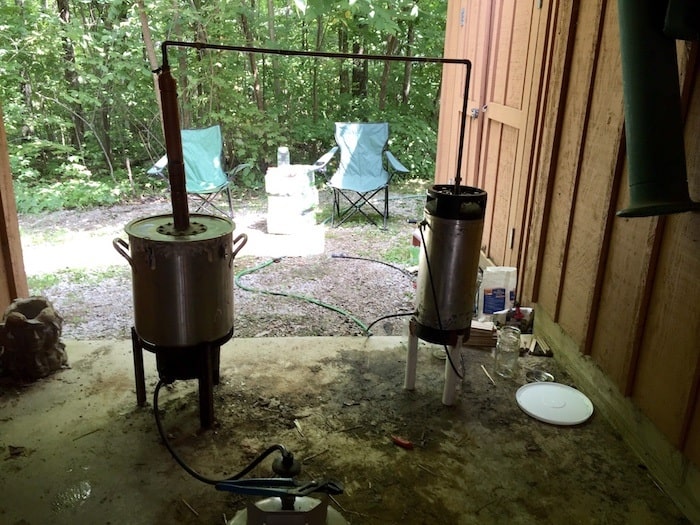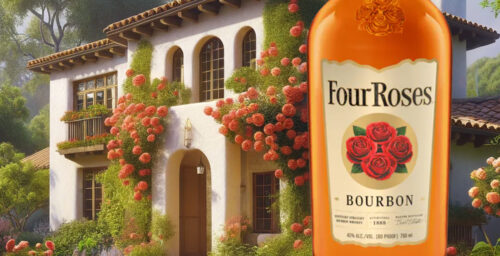Some people have a very romantic notion of the word “moonshine.” It sounds so nice, doesn’t it? We dream of makeshift stills chugging out some rough hooch by the light of the silvery moon, stuff we wouldn’t dream of sipping without a perfunctory wince. There’s an old-looking fella with a long beard and teeth like a lego block who answers to the name of Zeke or Clem, giggling maniacally as he fills up jugs labeled “XXXX” with it.
As the American craft whiskey exploded onto the scene, bottles (and sometimes cutesy mason jars) of clear whiskey were suddenly everywhere, and even the corporate companies started selling new make to compete. Some distillers have had the audacity to call their unaged high proof stuff, typically corn whiskey, produced in order to make a buck before their other whiskey comes of age “moonshine.” The thing is, moonshine was called such because it was the sort of spirit one had to make under cover of night because, HELLO, it was illegal!
While whiskey referred to as “moonshine” has been legal in the U.S. since 2010, I am of the opinion that to call it “genuine moonshine” is a bit misleading. So here’s a handy checklist:
- Were you apprehensive about buying the product in broad daylight when anyone can see the transaction take place?
- At any time, was a firearm a necessary component for a transaction between yourself and the purveyor?
- Was the distiller of said whiskey agitated when you asked to see the still on which it was produced, especially if you wanted a picture of it?
- To the best of your knowledge, have you, or anyone you know, been seriously threatened simply because you purchased that product from a certain purveyor?
- Does it need a hiding place for legal reasons, preferably behind a fake or secret door?
- Did you buy it in bulk with extra for safekeeping or special occasions in case there’s no other way to score hooch?
- To the best of your knowledge, has anyone ever chased you in a menacing way, especially at night, in order to steal that product from you, preferably by car at high speeds?
- Has the FBI or someone from the IRS come looking for you because you have it?
If you said yes to any or all of these, congratulations – you have real moonshine! If not, enjoy your unaged/unbarreled high proof whiskey.
The Real Deal
While I was in Kentucky recently, I got to see an actual moonshine operation, stuff that is made for private consumption that is not and will never be marketed commercially. It’s produced in the rather cinematic, rolling hills of horse country in an annex of a garage adjacent to a big house. The distiller, who must remain anonymous for legal reasons, began producing it several years ago, inspired by a close friend who made home whiskey as a hobby.
Until that afternoon, my only experience with a home still was watching Alan Alda as Hawkeye Pierce and his Army doc pals drink Martinis from home stilled gin in the 1970s and 80s on TV in M*A*S*H (which stands for Mobile Army Surgical Hospital, not what goes into the still. Though for a show about war docs who were technically on call 24/7 they drank so much alcohol the title fits in that sense).
What I didn’t expect is how conscientious a home distiller in the Kentucky back country could be about choosing a whiskey mash bill (for his favorite recipe called Sweet Feed, he settled on six parts corn from good quality horse feed, two parts rye, and two parts malted barley). If Hawkeye and Trapper John had sophisticated distilling tools such as a hydrometer, we never got to see it on TV, but here I was able watch as the gravity of the fermenting grains was tested with one before it was decided it would be ready to cook.
The still itself is rather cute and tiny, but effective, with two metal pots connected by a pipe. The cook time lasts about two hours, with the proof carefully monitored to determine where to cut the heads and tails. This is done generously so the remaining heart isn’t too astringent. Distilled water, made from one of those inexpensive pitcher-type liquid distillers that can be bought online, is used to bring the whiskey to proof to a sweet spot between 80 and 85 proof.
It was time to taste Sweet Feed and some of the other experimental homemade whiskeys and spirits. I’ve gotta say, it’s quite a sight better than much of the unaged whiskey I’ve tasted from full fledged commercial distilleries. Sweet Feed is a tad viscous and chewy, but with a pleasant raisin bran flavor and not nearly as much burn as one would expect. I also quite enjoyed a recipe with a higher rye content (all of them are stored in jars with the grain ratios sharpied onto the lid, stocked in the kitchen cabinet). He’s even tried adding charred wood staves to the whiskeys for “aging,” and has experimented with different levels of char and maturation periods. These were not my favorite of the whiskeys I sampled, but at least in this instance there wasn’t much riding on them either. No one is betting the farm that they will outsell something matured in 53 gallon barrels in a few years. He’s also played around with distilling ciders, and I especially liked the Vanilla Apple Pie recipe.
It was a pleasure to drink whiskey that’s made simply for the fun of it, kind of like having homemade pizza with scratch dough vs. ordering a pie for delivery. The experience also made me appreciate the effort that goes into every bottle of the commercial stuff on my shelf all that much more.









